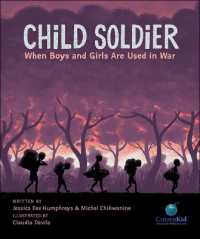- ホーム
- > 洋書
- > 英文書
- > Performing Arts
Full Description
A roadmap for understanding and creating comedy from the visionary Second City comedy director
Great comedy can feel ineffable—and unlearnable. Debunking the myth that "either you are funny, or you aren't," Libera breaks the magic of comedy down into an innovative theory and practical toolkit. Developed over the course of thirty years as a director for The Second City and professor of comedy studies in their training center, Libera's approach is effective across stand-up, sketch, film, and television comedy, as evidenced by her powerhouse students: Jordan Peele, Amy Poehler, Kristen Schaal, Steven Yeun, and many more of your favorites.
This book starts with a way to think about comedy and then guides you through concrete strategies for making your work smarter, richer, funnier. Libera covers everything from generating material to revising and performing to fostering social connection through comedy. In the book's final section, Libera draws from her personal life to make a profound case for why future comedy writers should consider the ethics of their art and their responsibility to their fellow human beings in the audience. Readers won't just be funnier because of this book—they'll be better people.
Contents
Foreword
Introduction
Part I: Thinking About Comedy
Introduction
A Theory of Comedy
Recognition
Distance
Pain
Comedy is Relative
Comedy Theory Overview (please cut this section, per ACQ notes)
The Five Components of Comedy
Jokes
Physical Comedy
Character
Narrative
Point of View
Thick and Thin Comedy
Taste, Hack, and Watching Comedy as a Comedian
Analyzing Comedy That Someone Else Has Created
Humor Theory For Comedians
Superiority Theory
Incongruity Theory
Tension and Release Theory
Benign Violation Theory
Evolutionary Theories of Humor and Laughter
Not Exactly Humor Theory But As Long As We're Here, Let's Talk About Comedy and Your Brain
Biases and Heuristics
Anchoring Bias
Salience Bias
Story Coherence
Tool—Context: Physical (Where Are You?)
Tool—Context: Capitalism (Who is the Customer?)
Putting the Frog Back Together
Part I: Making It Funny
Introduction
Generating Comedy Materials and Ideas
Types of Material Generation Prompts
Creating Prompts That Use the Elements of Pain and Distance
Material Generation Prompts
Tool—Truth
How to Write a Joke
Defining Jokes
How to Write a Joke
How to Write a News Joke
Creating Original Jokes
Joke Filters
How to Rewrite a Joke
Jokes That Use Other Comedy Components
Revising Jokes That Use More Than One Component
Tool—Novelty and Surprise
Performing Comedy
Defining Comedy in Performance
Tool—Discovery
Tool—Explore and Heighten
Defining Physical Comedy
Making Physical Comedy
Props
Slapstick
Tool—Status
Performing Comedy
Creating Comic Characters
Defining Comic Character
Creating Comedic Characters
Tool—Character Space Walk
More Ways to Create or Practice With Embodied Characters
Playing With Character Point of View For Writers
Good Comedy Hygiene: Character
Tool—Useful Definitions
Persona
Defining Persona
Creating Your Comic Persona
Tool—Persona Worksheet
Point of View
Defining a Point of View
Point of View 101: you Already Have a Point of View
Comedic Opinion
Tool—Useful Definitions (Irony and Sarcasm)
Parody and Satire
Creating Parody
Creating Satire
Tool—Useful Definitions (Parody and Satire)
Creating Comedic Narratives
Story and Narrative: A Quick Introduction
Defining Comedic Narrative
Tool—Useful Definitions (Farce)
Comic Premise
Starting With a Comic Idea
Writing a Short Comedy Piece
Sketch
Sitcom
Tool—Putting Characters Into Comedic Stories
Tool—Thinking About Structure
Variety Narratives
Defining Variety Narratives
How to Write a Simple Standup Set
Sketch Running Order
Running Order Outlines
Running Order Hierarchy of Needs
Part III: Making It Funnier
Introduction
Tool—Expectations
Tool—Risk and Failure
Tool—Taking a Comedy Class
Next Steps of Revising
Digging Into the Comedy Triad: Recognition, Pain, Distance
Looking at Structure
The Five Comedy Components
The Obvious
Part IV: Making It Better
Introduction
Thinking About Comedy Ethics
Making Your Comedy More Ethical
Comedy to Read and Watch
Acknowledgments
Notes








